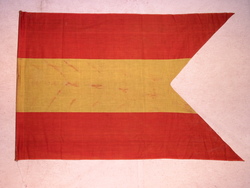

OBVERSE
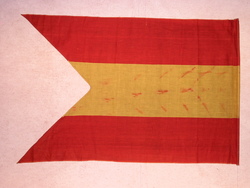
REVERSE
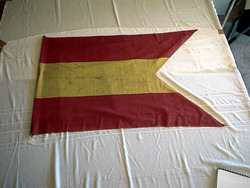
Obverse
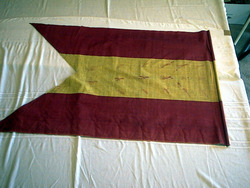
Reverse
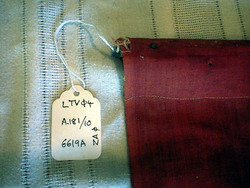
Tag








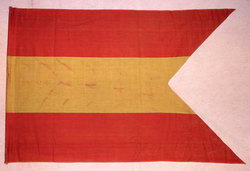
Obverse - 2
Spain Guidon Variant, Spanish American War.
Sub-collection: de Young MuseumA swallow-tailed variant of the Spanish National flag.
This swallow-tailed Spanish civil flag was formerly part of the collection of the M.H. de Young Museum. Founded in 1895 in San Francisco's Golden Gate Park, the de Young Museum was San Francisco's first museum. It was a great success from its opening and has been an integral part of the cultural fabric of the city and a cherished destination for millions of residents and visitors to the region for over 100 years.
Michael Henry de Young, 1849 -1925, was an American journalist and businessman who owned and published the San Francisco Chronicle. He used his wealth to further his eclectic tastes and accumulated a collection of immense variety, and such diverse objects such as sculptures, paintings, flags, polished tree slabs, paintings, objet d'art, jewellery, a door reputedly from Newgate Prison, birds' eggs, handcuffs and thumbscrews, and a collection of knives and forks.
As San Francisco's premier repository, the de Young Museum came to house a number of flags associated with the American acquisition of the Philippines after the Spanish American War.
Very little is known about the history or acquisition of this war trophy. In ancient Greece and Rome, military victories were often formally commemorated with a display of captured arms and standards and cultural objects, called war trophies. In the Middle Ages; the European wars of the 17th and 18th centuries; and during the Napoleonic Wars variations of this were also practiced wherein armies returning home would often display flags captured from the enemy in public buildings or churches. In a public space flags were displayed as either a moral builder, an overt symbol of victory, or as a reminder of a past martial or naval accomplishment. In a church or place of worship they were displayed in homage to Divinity for granting victory, or as a symbol of the power of the providence of God for their cause.
In the American Civil War official protocols were evolved for the disposition of captured colors. The act was considered worthy of decoration or promotion. More recently the World Wars saw the wholesale confiscation of enemy property including flags. In 20th century it became common for individual soldiers to return home with trophies and souvenirs, such as enemy flags.
After the Civil War American soldiers were no less interested in war trophies; however the dominant foe, the Native American Indians, did not use flags. This changed when during both the Spanish American & Philippine American Wars, American soldiers once again prized enemy flags. The possession of a captured enemy flag is often considered the ultimate war trophy; literally one has captured the flag.
During the Spanish-American War many American soldiers and sailors brought home flags which had been locally made in the Philippines as trophy souvenirs. This flag appears to be one of those, and was probably locally made. The size and lack of coat of arms suggest that it may have been homemade for display by a Spanish family to show their patriotism or for some kind of celebration. Also, the fact that the red-yellow-red stripes are not in a 1:2:1 ratio as they should be also suggests that the flag was homemade.
The national colors of Spain have been red and yellow since 1785. Prior to that, those colors were common in the banners of individual Spanish regions and military units. Officially, there had always been a coat of arms on the yellow stripe until 1928. Those arms had changed over the years to indicate the particular king or other ruling figure. Because most coats of arms were of a complex design, they were frequently omitted when flags were made by private individuals. The resulting design was still recognizable as being Spanish; just as red-white-blue bunting is often used in the United States instead of the Stars and Stripes.
The burgee in this Collection is "swallowtailed", that is, there is a triangular section cut out at the fly end. Flags of this kind were flown prominently on ships so that other vessels would know the ranking officer aboard. It is also possible that this flag simply served as decoration. The national flag colors are frequently used in Spain without the official coat of arms. As a decoration, such flags sometimes have a swallowtailed shape rather than the normal rectangle.
This flag is in good condition with a slight discoloration of the central stripe. It is made from cotton and machine-stitched.
Exhibition History:
First Presidio Exhibit
(ZFC0205)
Spanish Military Field Guidon
ZFC Significant Flag
Item is Framed
Sources:
History of the de Young Museum, de Young, Fine Arts Museums of San Francisco, 15 November 2011: http://deyoung.famsf.org/about/history-de-young-museum
War Trophy, Wikipedia, 15 November 2011, from:
http://en.wikipedia.org/wiki/War_trophy
Michael Henry de Young, Wikipedia, 15 November 2011, from: http://en.wikipedia.org/wiki/M._H._de_Young
Historical Flags 1785-1931 (Spain), Wikipedia, 15 November 2011, from: http://www.crwflags.com/fotw/flags/es1785.html
Image Credits:
Zaricor Flag Collection
Hoist & Fly | |
|---|---|
| Width of Hoist | 44 |
| Length of Fly | 29.5 |
Stripes | |
|---|---|
| Width of 1st Stripe | 9.5 |
| Width of Last Stripe | 10.5 |
| Size of Hoist | 1.75 |
Frame | |
|---|---|
| Is it framed? | yes |
| Frame Height | 36.25 |
| Frame Length | 48.5 |
Stars | |
|---|---|
| Are there stars on obverse? | no |
| Are there stars on reverse? | no |
Stripes | |
|---|---|
| Number of Stripes | 3 |
| Color of Top Stripe | Red |
| Color of Bottom Stripe | Red |
| Has a Blood Stripe? | no |
| Comments on Stripes | Middle Stripe : White : 10.5" |
Nationality | |
|---|---|
| Nation Represented | Spain |
Fabric | |
|---|---|
| Fabric | Cotton |
Stitching | |
|---|---|
| Stitching | Machine |
Thread | |
|---|---|
| Thread Material | Cotton |
Attachment | |
|---|---|
| Comments on Method of Attachmen | Sleeve with pole of same size passing in it |
Documentation | |
|---|---|
| Documents |
All original documents and drawings are held in the Zaricor Flag Collection Archives.
|
| Drawings |
All original documents and drawings are held in the Zaricor Flag Collection Archives.
|
| Research Documents | |
| Public Copy & Signs | |
Condition | |
|---|---|
| Condition | Good |
| Damage | Red staining in the yellow stripe |
| Displayable | yes |
Exhibits | |
|---|---|
| Exhibition Copy | First Presidio Exhibit (ZFC0205) Spanish Military Field Guidon Date: 1898 Medium: Printed on cotton Comment: Although similar to Spanish Admiralty Rank flags, this swallowtail version of the Spanish national flag does not bear the symbols indicative of naval ranks. It is suspected, instead, that it is an unissued Spanish military guidon. It was probably brought to the United States by a soldier returning from the Spanish-American War. Provenance: Acquired by the Zaricor Flag Collection (ZFC0205) in 1997 from the De Young Museum Collection through Butterfield & Butterfield Auctions of San Francisco, CA. |



